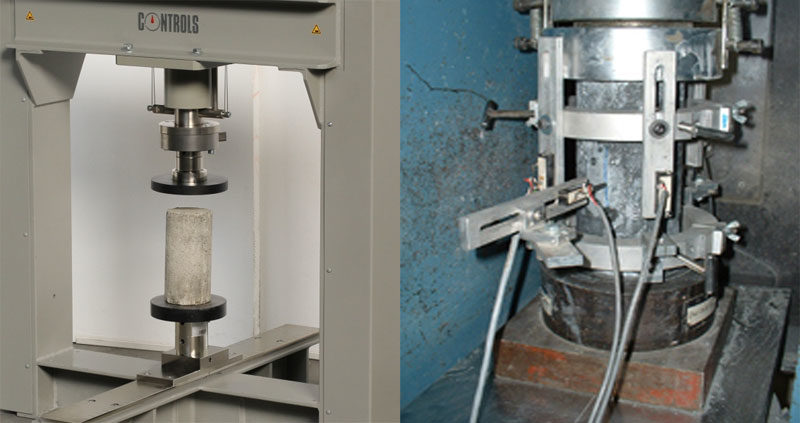What is the Modulus of Elasticity?
Modulus of elasticity (also known as elastic modulus, the coefficient of elasticity) of a material is a number that is defined by the ratio of the applied stress to the corresponding strain within the elastic limit. Physically it indicates a material’s resistance to being deformed when stress is applied to it. Modulus of elasticity also indicates the stiffness of a material. The value of elastic modulus is higher for stiffer materials.
\[\text {Modulus of Elasticity,}\; E=\frac{f}{s} \]
Here, f= applied stress on a body
s= strain to correspond to the applied stress
 Determination of Modulus of Elasticity Concrete. Source: http://civilarc.com
Determination of Modulus of Elasticity Concrete. Source: http://civilarc.com
Units of Elastic Modulus
Units of elastic modulus are the followings:
Modulus of Elasticity of Concrete
Modulus of Elasticity of Concrete can be defined as the slope of the line drawn from stress of zero to a compressive stress of 0.45f’c. As concrete is a heterogeneous material. The strength of concrete is dependent on the relative proportion and modulus of elasticity of the aggregate.
To know the accurate value of elastic modulus of a concrete batch, a laboratory test can be done. Also, there are some empirical formulas provided by different codes to obtain the elastic modulus of Concrete. These formulas are based on the relationship between the modulus of elasticity and concrete compressive strength. One can easily obtain an approximate value of the modulus of elasticity of concrete using 28 days of concrete strength (f’c) with these formulas. {adselite}
Elastic Modulus of Concrete from ACI Code
Different codes have prescribed some empirical relations to determine the Modulus of Elasticity of Concrete. A few of them are given below.
According to ACI 318-08 section 8.5,
Modulus of elasticity for concrete,
\[E_{c}=w_c^{1.50}\times0.043\sqrt{f'_{c}} \quad MPa \]
This formula is valid for values of wc between 1440 and 2560 kg/m3.
For normal-weight concrete,
\[E_{c}=4700\sqrt{f'_{c}} \quad MPa\\
(in \quad FPS \quad unit \quad E_{c}=57000\sqrt{f'_{c}} \quad psi)
\]
Elastic Modulus of Concrete from BNBC
According to BNBC 2006 section 5.13.2.1,
For stone aggregate concrete,
\[E_{c}=44\ w_c^{1.50}\sqrt{f'_{c}} \quad N/mm^2
\]
When wc between 15 and 25 kN/m3 and √f’c in N/mm2.
\[E_{c}=4700\sqrt{f'_{c}} \quad N/mm^2
\]
for normal density concrete
For brick aggregate concrete,
\[E_{c}=3750\sqrt{f'_{c}} \quad N/mm^2
\]
Test to Determine Elastic Modulus of Concrete
The following video (source: youtube.com) will help you to get a good idea about the experimental procedure of determining the modulus of elasticity of concrete. In this video, the test procedure to determine the elastic modulus of concrete is illustrated following the EN 12390-13 code.
Related Articles
- Uses of Concrete
- Advantages and Disadvantages of Concrete
- Advantages and Disadvantages of Reinforced Concrete
- What is Prestressed Concrete? How Does It Work?
- Types of Pre-stressed Concrete
- Advantages and Disadvantages of Prestressed Concrete
- Vacuum Concrete | Definition, Procedure, and Advantages
- What is Precast Concrete?
- Advantages and Disadvantages of Precast Concrete
- Difference Between Cinder Block and Concrete Block

